Effect of Spray Distance and Powder Feed Rate on Particle Velocity in Cold Spray Processes
Abstract
:1. Introduction
2. Materials and Methods
3. Results
3.1. Particle Velocity at Different Spray Distances
3.2. Particle Velocity at Different Powder Feed Rates
4. Discussion
5. Conclusions
- There exists a highest average velocity of 781 m/s at an optimum spray distance of 8 cm. The velocity increases from 744 m/s at a 3 cm spray distance and then decreases beyond an 8 cm spray distance. This is because the powders continue to accelerate even after leaving the nozzle exit.
- The average particle velocity decreases in a linear manner at 11 m/s per centimeter after the optimum spray distance of 8 cm.
- The effect of powder feed rate on Inconel 625 powders is less significant; a drop in velocity of 2.77% was observed by increasing the powder feed rate from 5.45 to 92.65 g/min. This is because Inconel 625 has a high density.
- Cold spray of a single Inconel 625 particle on Inconel 625 substrate at a 20 cm standoff distance with pronounced jetting was achieved, indicating that deposition of cold sprayed Inconel 625 coating can be achieved at large standoff distances.
- Coatings with low porosity and high hardness were produced at the optimum standoff distance of 8 cm compared to the commonly used standoff distance of 3 cm.
- Deposition on different types of substrate material was achieved by cold spraying Inconel 625 powders within the range of the parameters discussed in this study.
Author Contributions
Funding
Institutional Review Board Statement
Informed Consent Statement
Data Availability Statement
Acknowledgments
Conflicts of Interest
References
- Yin, S.; Cavaliere, P.; Aldwell, B.; Jenkins, R.; Liao, H.; Li, W.; Lupoi, R. Cold spray additive manufacturing and repair: Fundamentals and applications. Addit. Manuf. 2018, 21, 628–650. [Google Scholar] [CrossRef]
- Assadi, H.; Gärtner, F.; Stoltenhoff, T.; Kreye, H. Bonding mechanism in cold gas spraying. Acta Mater. 2003, 51, 4379–4394. [Google Scholar] [CrossRef]
- Bhattiprolu, V.S.; Johnson, K.W.; Ozdemir, O.C.; Crawford, G.A. Influence of feedstock powder and cold spray processing parameters on microstructure and mechanical properties of Ti-6Al-4V cold spray depositions. Surf. Coat. Technol. 2018, 335, 1–12. [Google Scholar] [CrossRef]
- Bhattiprolu, V.S.; Johnson, K.W.; Crawford, G.A. Influence of powder microstructure on the microstructural evolution of as-sprayed and heat treated cold-sprayed Ti-6Al-4V coatings. J. Therm. Spray Technol. 2018, 28, 174–188. [Google Scholar] [CrossRef]
- Wu, K.; Sun, W.; Tan, A.W.-Y.; Marinescu, I.; Liu, E.; Zhou, W. An investigation into microstructure, tribological and mechanical properties of cold sprayed Inconel 625 coatings. Surf. Coat. Technol. 2021, 424, 127660. [Google Scholar] [CrossRef]
- Wu, K.; Chee, S.W.; Sun, W.; Tan, A.W.-Y.; Tan, S.C.; Liu, E.; Zhou, W. Inconel 713C coating by cold spray for surface enhancement of Inconel 718. Metals 2021, 11, 2048. [Google Scholar] [CrossRef]
- Hajipour, H.; Abdollah-zadeh, A.; Assadi, H.; Taheri-Nassaj, E.; Jahed, H. Effect of feedstock powder morphology on cold-sprayed titanium dioxide coatings. J. Therm. Spray Technol. 2018, 27, 1542–1550. [Google Scholar] [CrossRef] [Green Version]
- Munagala, V.N.V.; Akinyi, V.; Vo, P.; Chromik, R.R. Influence of powder morphology and microstructure on the cold spray and mechanical properties of Ti-6Al-4V coatings. J. Therm. Spray Technol. 2018, 27, 827–842. [Google Scholar] [CrossRef]
- Munagala, V.N.V.; Bessette, S.; Gauvin, R.; Chromik, R.R. Sliding wear of cold sprayed Ti-6Al-4V coatings: Effect of porosity and normal load. Wear 2020, 450–451, 203268. [Google Scholar] [CrossRef]
- Sirvent, P.; Garrido, M.Á.; Sharp, J.; Rainforth, W.M.; Poza, P. Improving the oscillating wear response of cold sprayed Ti-6Al-4V coatings through a heat treatment. Surf. Coat. Technol. 2020, 399, 126128. [Google Scholar] [CrossRef]
- Vidaller, M.V.; List, A.; Gaertner, F.; Klassen, T.; Dosta, S.; Guilemany, J.M. Single impact bonding of cold sprayed Ti-6Al-4V powders on different substrates. J. Therm. Spray Technol. 2015, 24, 644–658. [Google Scholar] [CrossRef]
- Pattison, J.; Celotto, S.; Khan, A.; O’Neill, W. Standoff distance and bow shock phenomena in the cold spray process. Surf. Coat. Technol. 2008, 202, 1443–1454. [Google Scholar] [CrossRef]
- Mauer, G.; Singh, R.; Rauwald, K.H.; Schrüfer, S.; Wilson, S.; Vaßen, R. Diagnostics of cold-sprayed particle velocities approaching critical deposition conditions. J. Therm. Spray Technol. 2017, 26, 1423–1433. [Google Scholar] [CrossRef]
- Khun, N.W.; Tan, A.W.Y.; Bi, K.J.W.; Liu, E. Effects of working gas on wear and corrosion resistances of cold sprayed Ti-6Al-4V coatings. Surf. Coat. Technol. 2016, 302, 1–12. [Google Scholar] [CrossRef]
- Cao, C.; Han, T.; Xu, Y.; Li, W.; Yang, X.; Hu, K. The associated effect of powder carrier gas and powder characteristics on the optimal design of the cold spray nozzle. Surf. Eng. 2020, 36, 1081–1089. [Google Scholar] [CrossRef]
- Meyer, M.C.; Yin, S.; McDonnell, K.A.; Stier, O.; Lupoi, R. Feed rate effect on particulate acceleration in cold spray under low stagnation pressure conditions. Surf. Coat. Technol. 2016, 304, 237–245. [Google Scholar] [CrossRef]
- Samareh, B.; Stier, O.; Lüthen, V.; Dolatabadi, A. Assessment of cfd modeling via flow visualization in cold spray process. J. Therm. Spray Technol. 2009, 18, 934–943. [Google Scholar] [CrossRef]
- Meyer, M.; Yin, S.; Lupoi, R. Particle in-flight velocity and dispersion measurements at increasing particle feed rates in cold spray. J. Therm. Spray Technol. 2016, 26, 60–70. [Google Scholar] [CrossRef] [Green Version]
- Sova, A.; Doubenskaia, M.; Petrovskiy, P.; Smurov, I. Visualization of particle jet in cold spray by infrared camera: Feasibility tests. Int. J. Adv. Manuf. Technol. 2017, 95, 3057–3063. [Google Scholar] [CrossRef]
- Hassani-Gangaraj, M.; Veysset, D.; Champagne, V.K.; Nelson, K.A.; Schuh, C.A. Adiabatic shear instability is not necessary for adhesion in cold spray. Acta Mater. 2018, 158, 430–439. [Google Scholar] [CrossRef]
- Schmidt, T.; Gärtner, F.; Assadi, H.; Kreye, H. Development of a generalized parameter window for cold spray deposition. Acta Mater. 2006, 54, 729–742. [Google Scholar] [CrossRef]
- Sun, W.; Tan, A.W.Y.; Khun, N.W.; Marinescu, I.; Liu, E. Effect of substrate surface condition on fatigue behavior of cold sprayed Ti-6Al-4V coatings. Surf. Coat. Technol. 2017, 320, 452–457. [Google Scholar] [CrossRef]
- Tan, A.W.-Y.; Sun, W.; Bhowmik, A.; Lek, J.Y.; Song, X.; Zhai, W.; Zheng, H.; Li, F.; Marinescu, I.; Dong, Z.; et al. Effect of substrate surface roughness on microstructure and mechanical properties of cold-sprayed Ti-6Al-4V coatings on Ti-6Al-4V substrates. J. Therm. Spray Technol. 2019, 28, 1959–1973. [Google Scholar] [CrossRef]
- Wong, W.; Vo, P.; Irissou, E.; Ryabinin, A.N.; Legoux, J.G.; Yue, S. Effect of particle morphology and size distribution on cold-sprayed pure titanium coatings. J. Therm. Spray Technol. 2013, 22, 1140–1153. [Google Scholar] [CrossRef]
- Neo, R.G.; Tham, N.Y.S.; Wu, K.; Puthan Veetil, S.; Tan, S.C.; Zhou, W. Evaluation of powders for cold spray coatings through study of single particle impact. In International Conference on Advanced Surface Enhancement, Proceedings of the 2nd International Conference on Advanced Surface Enhancement (INCASE 2021), Singapore, 7–8 September 2021, 1st ed.; Springer: Singapore, 2022; pp. 163–167. [Google Scholar]

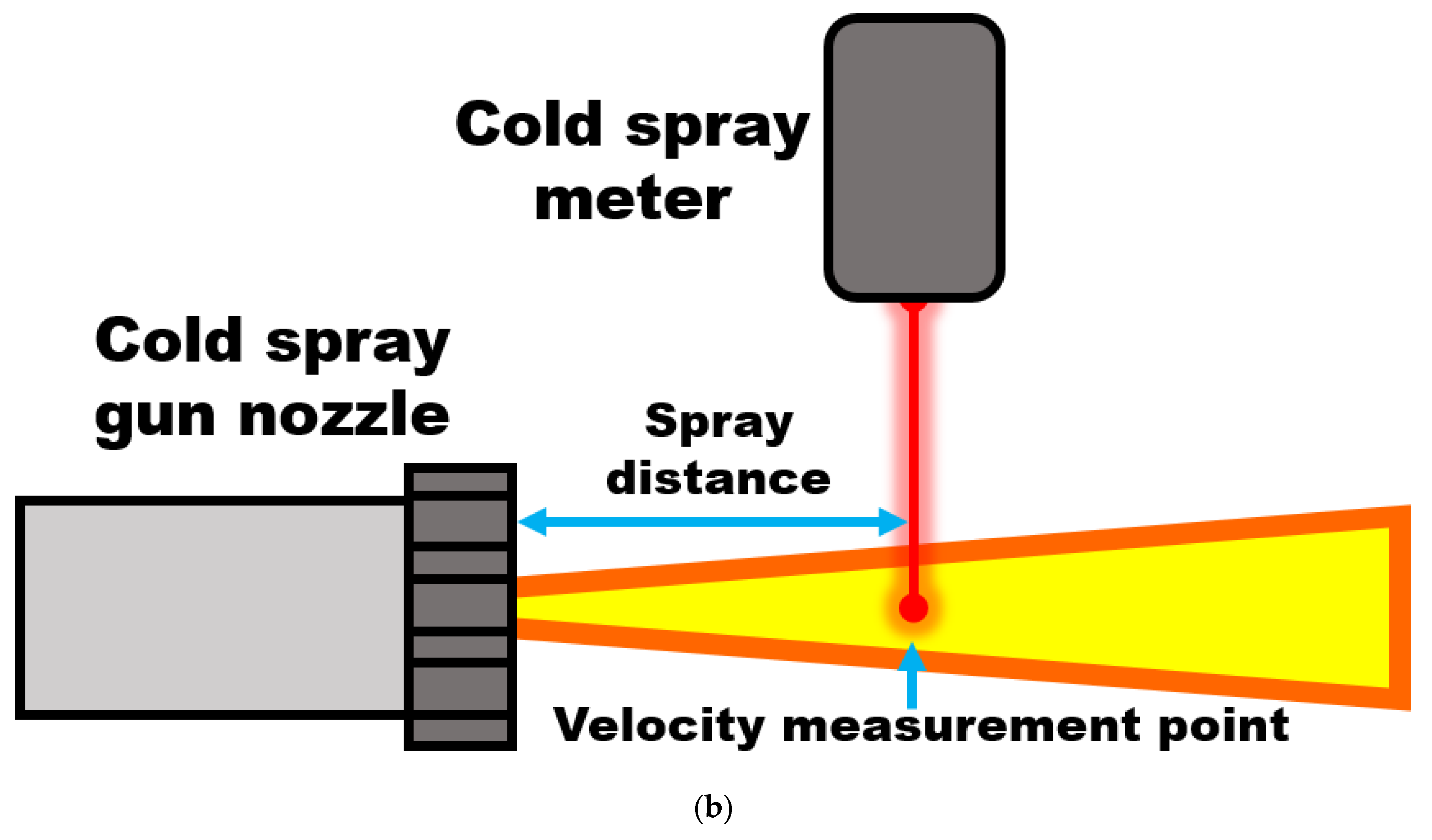

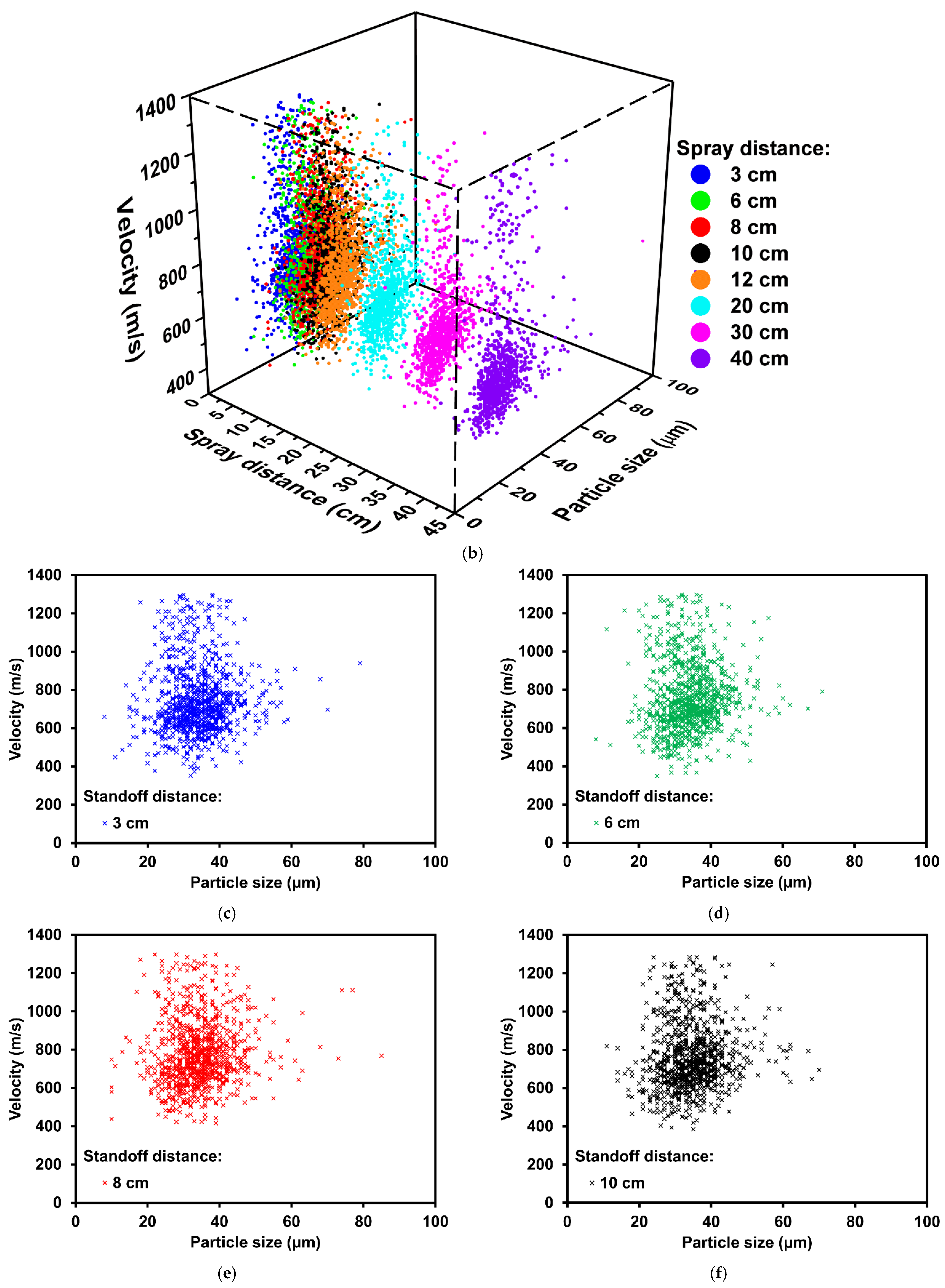

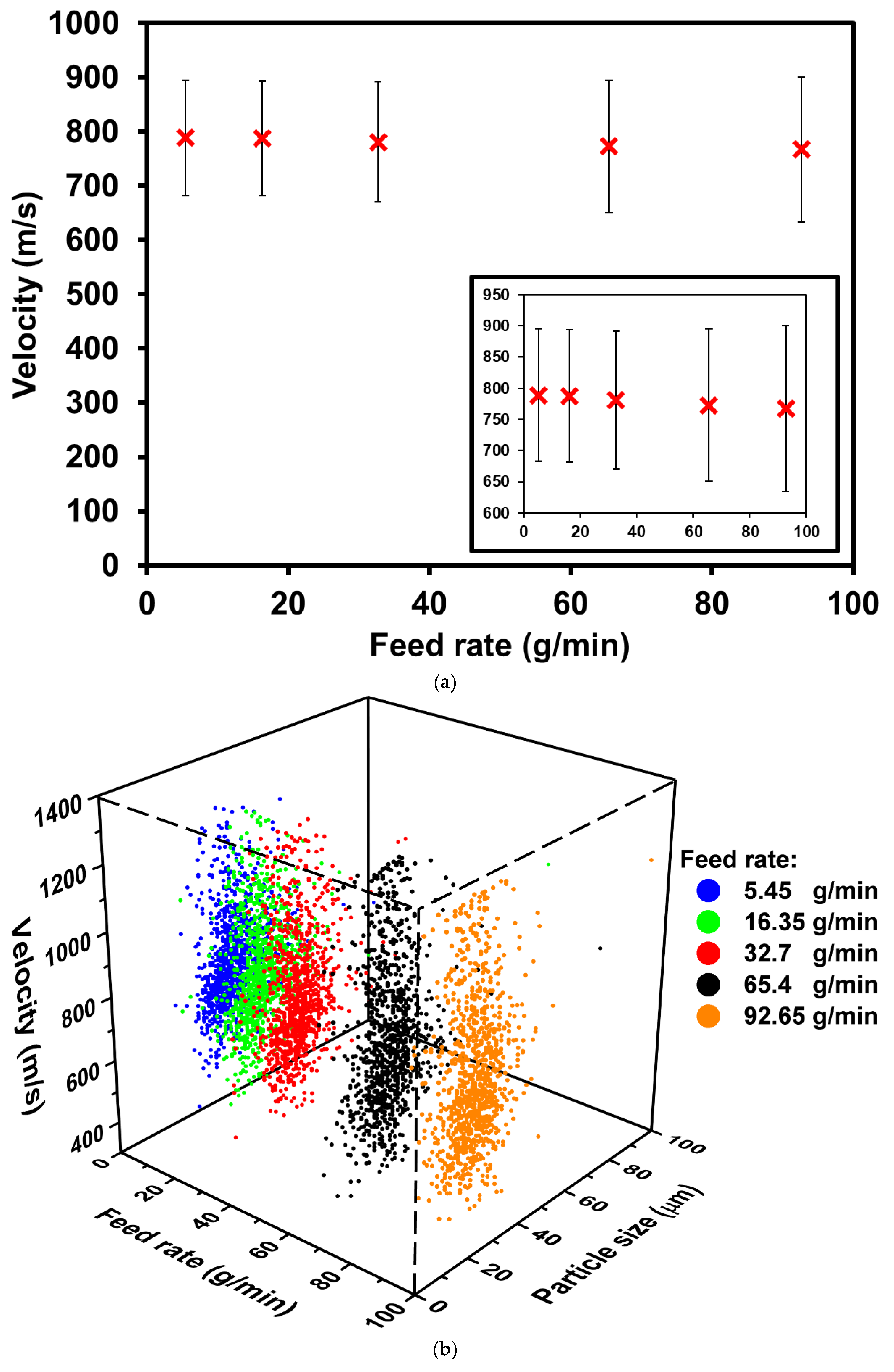

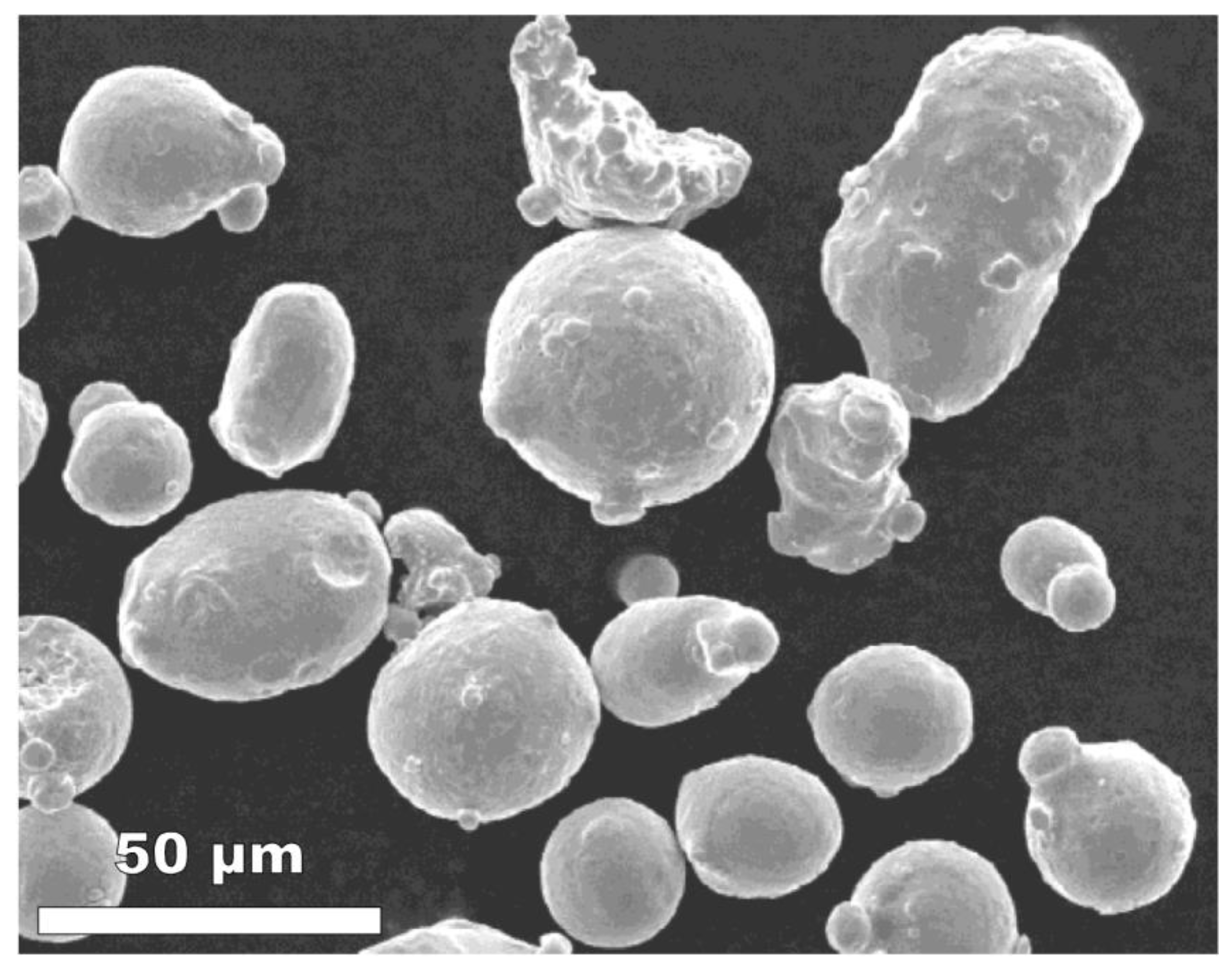

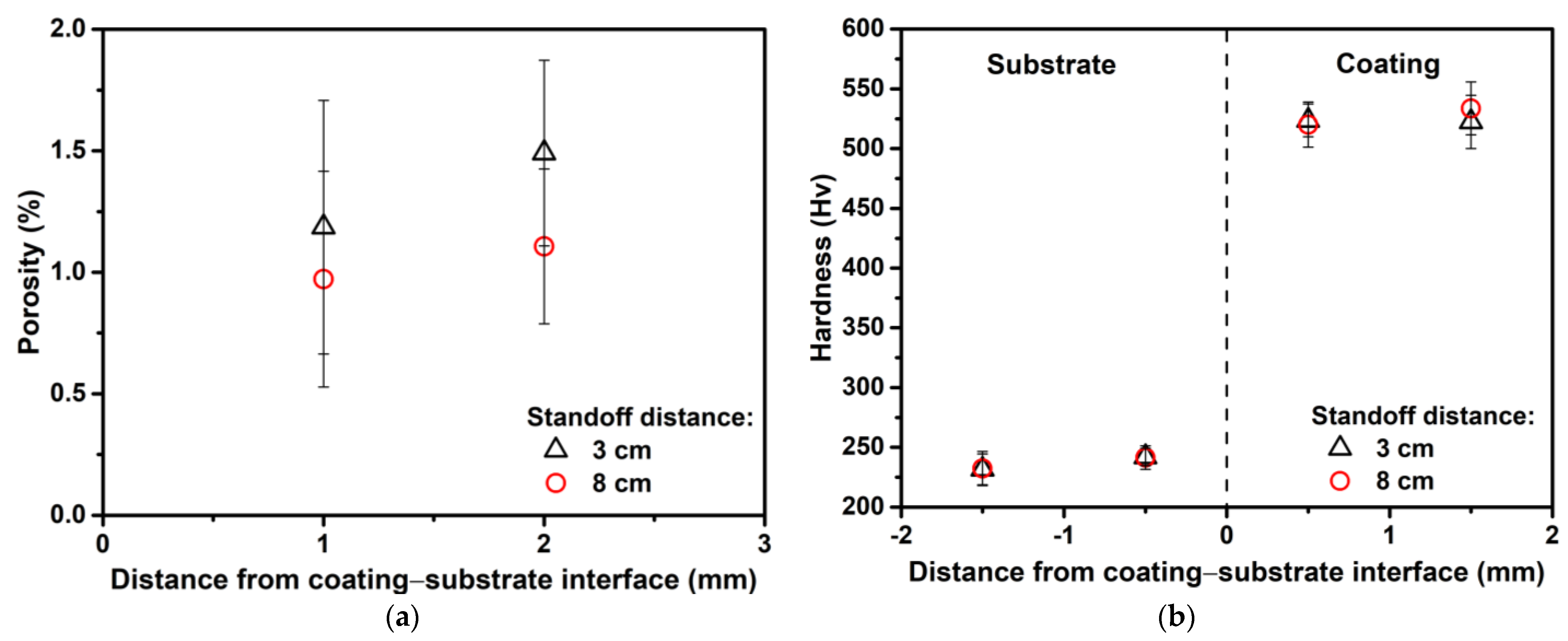

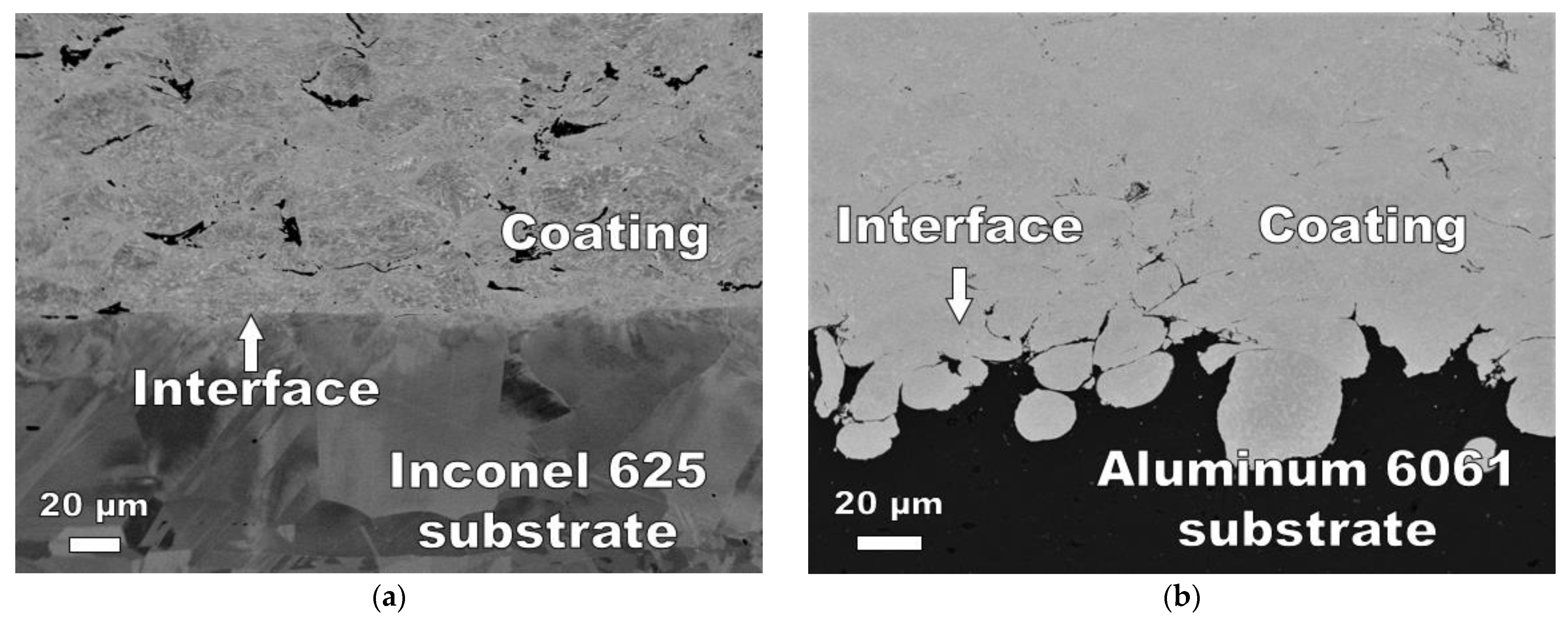
| Parameter | Value |
|---|---|
| Working gas | Nitrogen |
| Gas pressure | 4.5 MPa |
| Gas temperature | 1050 °C |
| Powder feed rate | 5.45 to 92.65 g/min |
| Spray distance | 3 to 40 cm |
Publisher’s Note: MDPI stays neutral with regard to jurisdictional claims in published maps and institutional affiliations. |
© 2022 by the authors. Licensee MDPI, Basel, Switzerland. This article is an open access article distributed under the terms and conditions of the Creative Commons Attribution (CC BY) license (https://creativecommons.org/licenses/by/4.0/).
Share and Cite
Neo, R.G.; Wu, K.; Tan, S.C.; Zhou, W. Effect of Spray Distance and Powder Feed Rate on Particle Velocity in Cold Spray Processes. Metals 2022, 12, 75. https://doi.org/10.3390/met12010075
Neo RG, Wu K, Tan SC, Zhou W. Effect of Spray Distance and Powder Feed Rate on Particle Velocity in Cold Spray Processes. Metals. 2022; 12(1):75. https://doi.org/10.3390/met12010075
Chicago/Turabian StyleNeo, Rong Gen, Kaiqiang Wu, Sung Chyn Tan, and Wei Zhou. 2022. "Effect of Spray Distance and Powder Feed Rate on Particle Velocity in Cold Spray Processes" Metals 12, no. 1: 75. https://doi.org/10.3390/met12010075
APA StyleNeo, R. G., Wu, K., Tan, S. C., & Zhou, W. (2022). Effect of Spray Distance and Powder Feed Rate on Particle Velocity in Cold Spray Processes. Metals, 12(1), 75. https://doi.org/10.3390/met12010075








